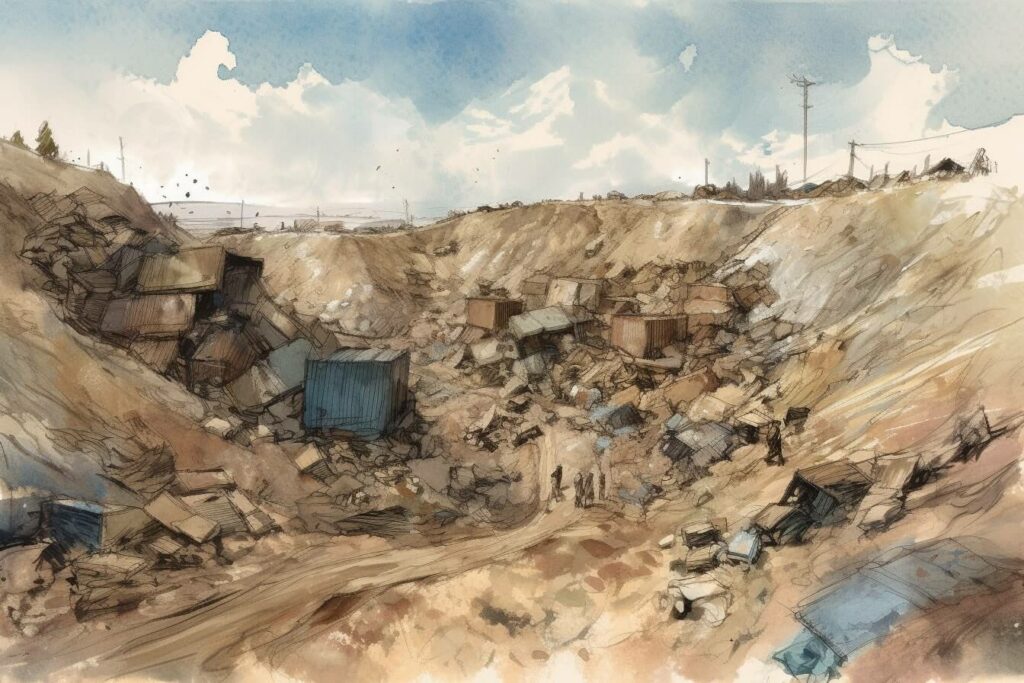



A 2-day immersion into the future of sustainable construction
As architects and interior designers, we are responsible for creating sustainable buildings and spaces that promote environmental stewardship and social responsibility. In doing so, we must consider all aspects of the built environment, including waste management and disposal.
Landfills have become integral to our modern society but pose significant environmental and health risks.
In this article, we will explore the definition of a landfill, its impact on our environment, and how architects and interior designers can create sustainable solutions to mitigate the impact of waste disposal.
Landfill Definition: What It Is?
A landfill is a designated area for disposing waste material that cannot be recycled or reused. Typically, a landfill is a large open pit lined with plastic or clay to prevent waste from seeping into the ground and contaminating the soil and groundwater.
Once the waste is placed in the landfill, it is compacted and covered with soil to reduce odors and discourage pests. Modern landfills are designed to capture and treat the gases produced by decomposing waste, which helps reduce air pollution and greenhouse gas emissions.
There are two primary types of landfills: sanitary landfills and open dumps. A sanitary landfill is a carefully engineered facility designed to protect the environment and public health by controlling and managing waste disposal. It is typically built with a liner system to prevent waste from seeping into the ground, and it is designed to capture and treat landfill gas.
On the other hand, open dumps are uncontrolled waste disposal sites with no environmental protections. They can pose serious health and environmental risks and are illegal in most countries.
Landfill Definition: What are its environmental impacts?
Landfills have a significant impact on the environment. The waste deposited in landfills can release harmful chemicals and pollutants into the soil and groundwater, contaminating local water sources and threatening public health.
Additionally, as the waste decomposes, it releases methane gas, a potent greenhouse gas contributing to climate change. Landfills also occupy valuable land, leading to habitat destruction and biodiversity loss.


Landfill Definition: How can architects and interior designers mitigate the impact of landfills?
As architects and interior designers, there are several ways that we can help to mitigate the impact of landfills. One approach is to focus on waste reduction and recycling.
By designing buildings and spaces that promote sustainable practices, such as recycling and composting, we can reduce the amount of waste in landfills. Additionally, we can design buildings that incorporate sustainable materials and systems that minimize waste production and environmental impact.
Another approach is to incorporate sustainable landscaping practices. By designing landscapes that incorporate native plants and utilize water-efficient irrigation systems, we can reduce the need for chemical fertilizers and pesticides, which can contaminate groundwater and soil. Sustainable landscaping practices can also help to improve air quality, reduce greenhouse gas emissions, and provide habitat for local wildlife.
Finally, architects and interior designers can incorporate sustainable waste management systems. For example, buildings can be designed with on-site waste treatment facilities that convert organic waste into compost or biogas, which can be used as a renewable energy source.
Additionally, buildings can be designed with waste-to-energy systems that convert waste into electricity, which can help to reduce greenhouse gas emissions and promote sustainable energy production.
Landfill Definition: A Conclusion
In conclusion, landfills are a necessary aspect of our waste management system but pose significant environmental and health risks. As architects and interior designers, we can play a critical role in mitigating the impact of landfills by designing buildings and spaces that incorporate sustainable waste management practices.
Suppose you want to learn more about sustainable design principles and practices. In that case, we invite you to explore UGREEN sustainability consultancy services or discover UGREEN Skills, our sustainability educational platform for professionals and companies. We can create a more sustainable future for our communities and planet.






A 2-day immersion into the future of sustainable construction
If you need our services in the Portuguese language, click here.

